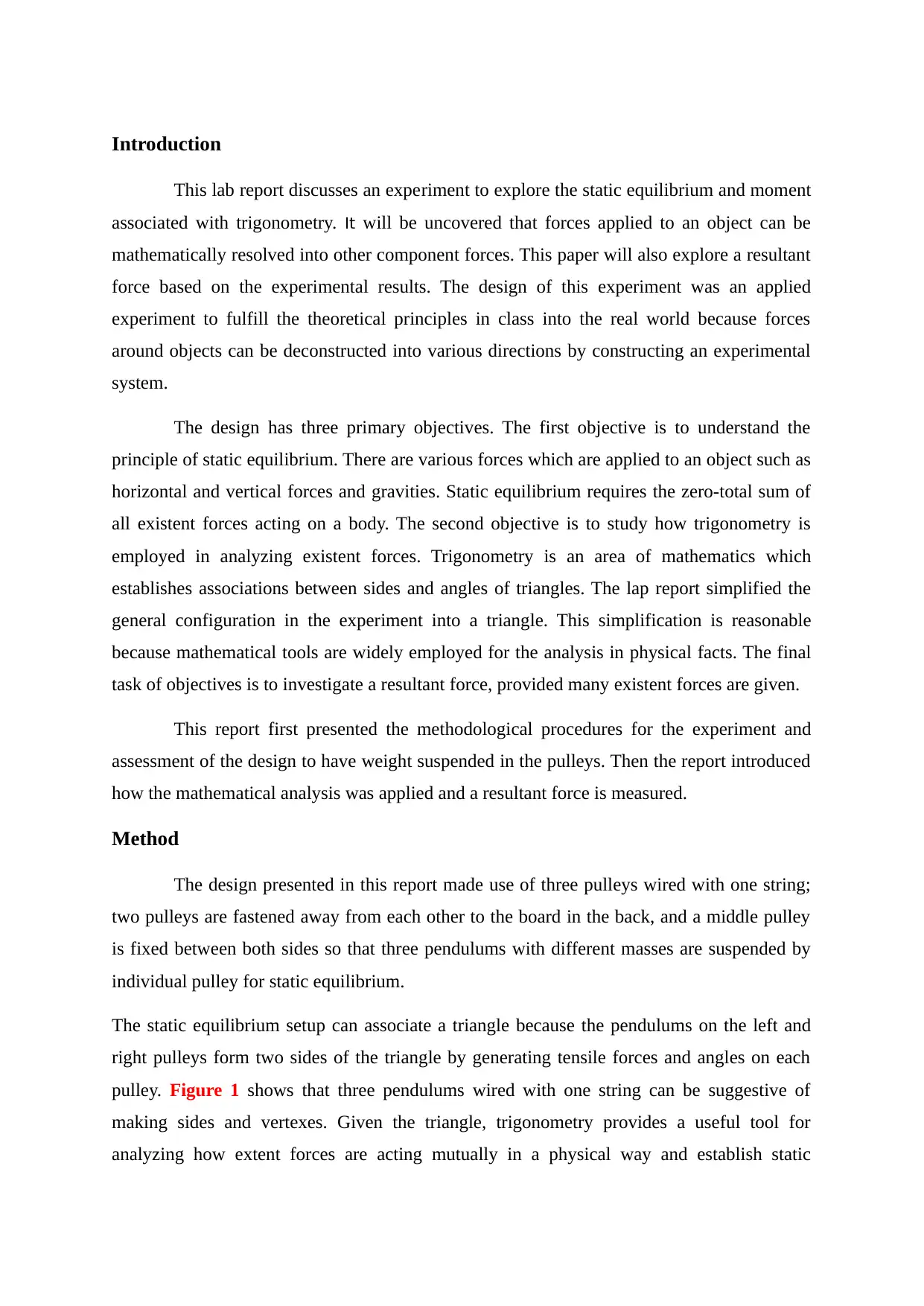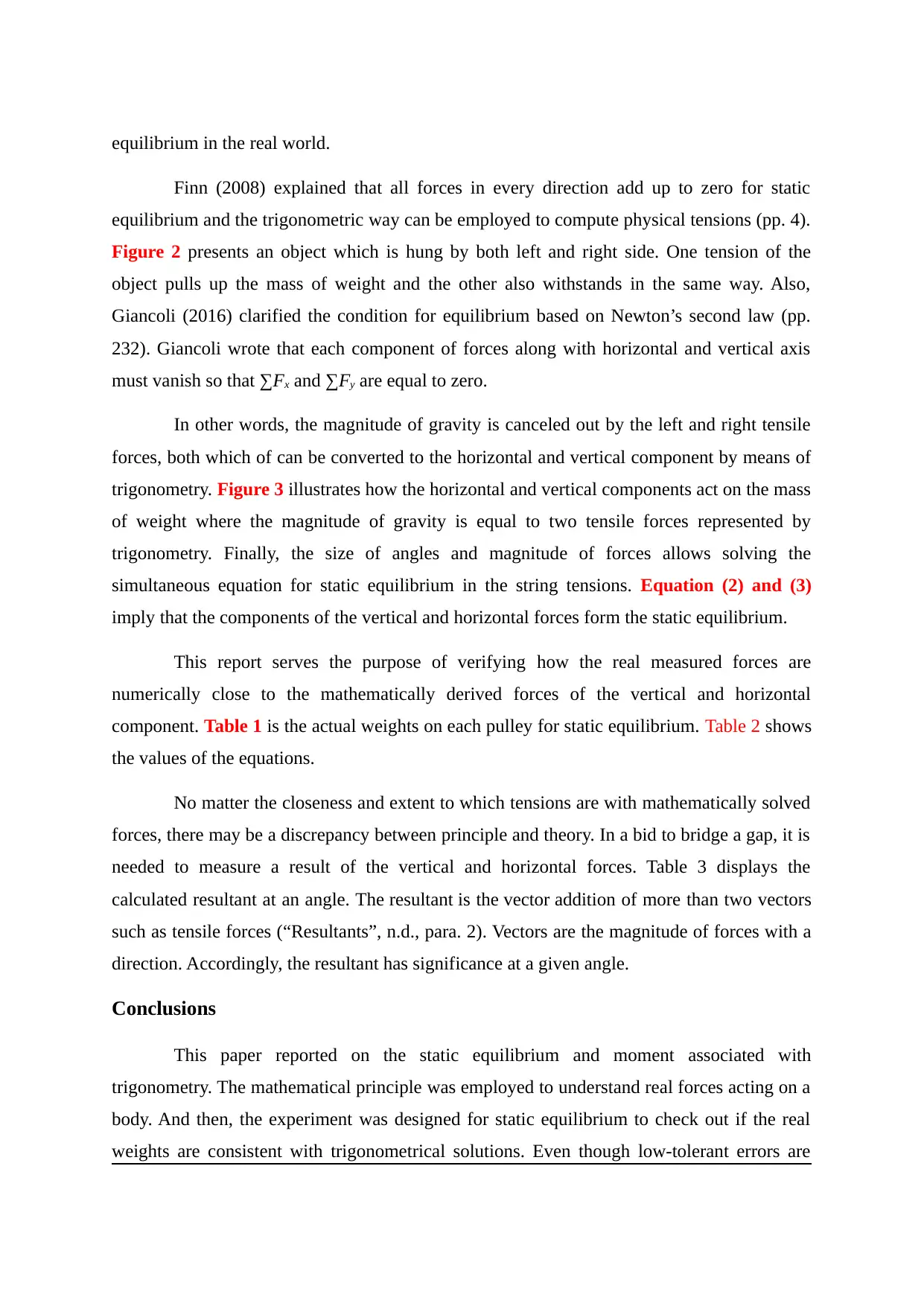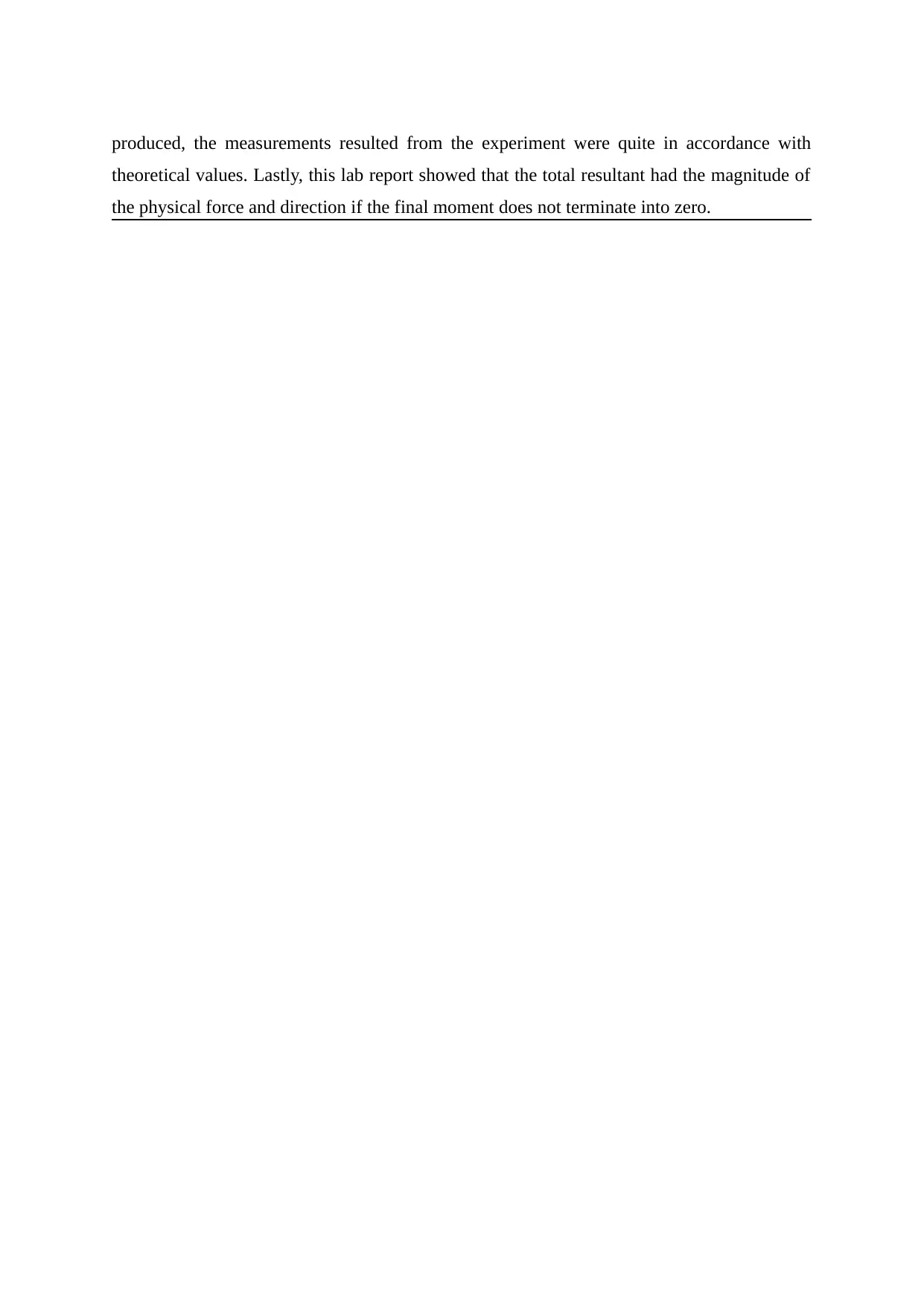Lab Report: Static Equilibrium, Trigonometry, and Resultant Forces
VerifiedAdded on 2022/09/15
|3
|887
|18
Report
AI Summary
This lab report details an experiment designed to explore static equilibrium and the role of trigonometry in analyzing forces. The experiment involved a system of pulleys and weights to demonstrate how forces can be mathematically resolved into components. The report's primary objectives wer...

Introduction
This lab report discusses an experiment to explore the static equilibrium and moment
associated with trigonometry. It will be uncovered that forces applied to an object can be
mathematically resolved into other component forces. This paper will also explore a resultant
force based on the experimental results. The design of this experiment was an applied
experiment to fulfill the theoretical principles in class into the real world because forces
around objects can be deconstructed into various directions by constructing an experimental
system.
The design has three primary objectives. The first objective is to understand the
principle of static equilibrium. There are various forces which are applied to an object such as
horizontal and vertical forces and gravities. Static equilibrium requires the zero-total sum of
all existent forces acting on a body. The second objective is to study how trigonometry is
employed in analyzing existent forces. Trigonometry is an area of mathematics which
establishes associations between sides and angles of triangles. The lap report simplified the
general configuration in the experiment into a triangle. This simplification is reasonable
because mathematical tools are widely employed for the analysis in physical facts. The final
task of objectives is to investigate a resultant force, provided many existent forces are given.
This report first presented the methodological procedures for the experiment and
assessment of the design to have weight suspended in the pulleys. Then the report introduced
how the mathematical analysis was applied and a resultant force is measured.
Method
The design presented in this report made use of three pulleys wired with one string;
two pulleys are fastened away from each other to the board in the back, and a middle pulley
is fixed between both sides so that three pendulums with different masses are suspended by
individual pulley for static equilibrium.
The static equilibrium setup can associate a triangle because the pendulums on the left and
right pulleys form two sides of the triangle by generating tensile forces and angles on each
pulley. Figure 1 shows that three pendulums wired with one string can be suggestive of
making sides and vertexes. Given the triangle, trigonometry provides a useful tool for
analyzing how extent forces are acting mutually in a physical way and establish static
This lab report discusses an experiment to explore the static equilibrium and moment
associated with trigonometry. It will be uncovered that forces applied to an object can be
mathematically resolved into other component forces. This paper will also explore a resultant
force based on the experimental results. The design of this experiment was an applied
experiment to fulfill the theoretical principles in class into the real world because forces
around objects can be deconstructed into various directions by constructing an experimental
system.
The design has three primary objectives. The first objective is to understand the
principle of static equilibrium. There are various forces which are applied to an object such as
horizontal and vertical forces and gravities. Static equilibrium requires the zero-total sum of
all existent forces acting on a body. The second objective is to study how trigonometry is
employed in analyzing existent forces. Trigonometry is an area of mathematics which
establishes associations between sides and angles of triangles. The lap report simplified the
general configuration in the experiment into a triangle. This simplification is reasonable
because mathematical tools are widely employed for the analysis in physical facts. The final
task of objectives is to investigate a resultant force, provided many existent forces are given.
This report first presented the methodological procedures for the experiment and
assessment of the design to have weight suspended in the pulleys. Then the report introduced
how the mathematical analysis was applied and a resultant force is measured.
Method
The design presented in this report made use of three pulleys wired with one string;
two pulleys are fastened away from each other to the board in the back, and a middle pulley
is fixed between both sides so that three pendulums with different masses are suspended by
individual pulley for static equilibrium.
The static equilibrium setup can associate a triangle because the pendulums on the left and
right pulleys form two sides of the triangle by generating tensile forces and angles on each
pulley. Figure 1 shows that three pendulums wired with one string can be suggestive of
making sides and vertexes. Given the triangle, trigonometry provides a useful tool for
analyzing how extent forces are acting mutually in a physical way and establish static
Paraphrase This Document
Need a fresh take? Get an instant paraphrase of this document with our AI Paraphraser

equilibrium in the real world.
Finn (2008) explained that all forces in every direction add up to zero for static
equilibrium and the trigonometric way can be employed to compute physical tensions (pp. 4).
Figure 2 presents an object which is hung by both left and right side. One tension of the
object pulls up the mass of weight and the other also withstands in the same way. Also,
Giancoli (2016) clarified the condition for equilibrium based on Newton’s second law (pp.
232). Giancoli wrote that each component of forces along with horizontal and vertical axis
must vanish so that ∑Fx and ∑Fy are equal to zero.
In other words, the magnitude of gravity is canceled out by the left and right tensile
forces, both which of can be converted to the horizontal and vertical component by means of
trigonometry. Figure 3 illustrates how the horizontal and vertical components act on the mass
of weight where the magnitude of gravity is equal to two tensile forces represented by
trigonometry. Finally, the size of angles and magnitude of forces allows solving the
simultaneous equation for static equilibrium in the string tensions. Equation (2) and (3)
imply that the components of the vertical and horizontal forces form the static equilibrium.
This report serves the purpose of verifying how the real measured forces are
numerically close to the mathematically derived forces of the vertical and horizontal
component. Table 1 is the actual weights on each pulley for static equilibrium. Table 2 shows
the values of the equations.
No matter the closeness and extent to which tensions are with mathematically solved
forces, there may be a discrepancy between principle and theory. In a bid to bridge a gap, it is
needed to measure a result of the vertical and horizontal forces. Table 3 displays the
calculated resultant at an angle. The resultant is the vector addition of more than two vectors
such as tensile forces (“Resultants”, n.d., para. 2). Vectors are the magnitude of forces with a
direction. Accordingly, the resultant has significance at a given angle.
Conclusions
This paper reported on the static equilibrium and moment associated with
trigonometry. The mathematical principle was employed to understand real forces acting on a
body. And then, the experiment was designed for static equilibrium to check out if the real
weights are consistent with trigonometrical solutions. Even though low-tolerant errors are
Finn (2008) explained that all forces in every direction add up to zero for static
equilibrium and the trigonometric way can be employed to compute physical tensions (pp. 4).
Figure 2 presents an object which is hung by both left and right side. One tension of the
object pulls up the mass of weight and the other also withstands in the same way. Also,
Giancoli (2016) clarified the condition for equilibrium based on Newton’s second law (pp.
232). Giancoli wrote that each component of forces along with horizontal and vertical axis
must vanish so that ∑Fx and ∑Fy are equal to zero.
In other words, the magnitude of gravity is canceled out by the left and right tensile
forces, both which of can be converted to the horizontal and vertical component by means of
trigonometry. Figure 3 illustrates how the horizontal and vertical components act on the mass
of weight where the magnitude of gravity is equal to two tensile forces represented by
trigonometry. Finally, the size of angles and magnitude of forces allows solving the
simultaneous equation for static equilibrium in the string tensions. Equation (2) and (3)
imply that the components of the vertical and horizontal forces form the static equilibrium.
This report serves the purpose of verifying how the real measured forces are
numerically close to the mathematically derived forces of the vertical and horizontal
component. Table 1 is the actual weights on each pulley for static equilibrium. Table 2 shows
the values of the equations.
No matter the closeness and extent to which tensions are with mathematically solved
forces, there may be a discrepancy between principle and theory. In a bid to bridge a gap, it is
needed to measure a result of the vertical and horizontal forces. Table 3 displays the
calculated resultant at an angle. The resultant is the vector addition of more than two vectors
such as tensile forces (“Resultants”, n.d., para. 2). Vectors are the magnitude of forces with a
direction. Accordingly, the resultant has significance at a given angle.
Conclusions
This paper reported on the static equilibrium and moment associated with
trigonometry. The mathematical principle was employed to understand real forces acting on a
body. And then, the experiment was designed for static equilibrium to check out if the real
weights are consistent with trigonometrical solutions. Even though low-tolerant errors are

produced, the measurements resulted from the experiment were quite in accordance with
theoretical values. Lastly, this lab report showed that the total resultant had the magnitude of
the physical force and direction if the final moment does not terminate into zero.
theoretical values. Lastly, this lab report showed that the total resultant had the magnitude of
the physical force and direction if the final moment does not terminate into zero.
⊘ This is a preview!⊘
Do you want full access?
Subscribe today to unlock all pages.

Trusted by 1+ million students worldwide
1 out of 3
Your All-in-One AI-Powered Toolkit for Academic Success.
+13062052269
info@desklib.com
Available 24*7 on WhatsApp / Email
![[object Object]](/_next/static/media/star-bottom.7253800d.svg)
Unlock your academic potential
© 2024 | Zucol Services PVT LTD | All rights reserved.

